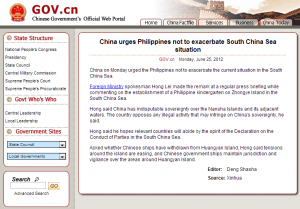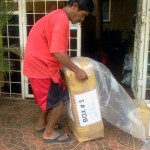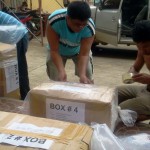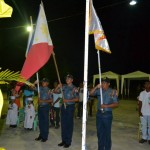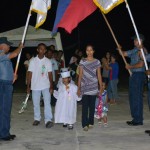
Philippine Defense Today (Adroth.ph)
In Defense of the Republic of the PhilippinesGUNNEX for Oto Melara ships
Saturday , 27, July 2013 AFP modernization, BRP Apolinario Mabini (PS-36), BRP Artemio Ricarte (PS-37), BRP Emilio Jacinto (PS-35), Jacinto class, Philippine Navy, WHEC Leave a commentThe Philippine Navy scheduled two separate gunnery exercises (GUNNEX) for ships armed with Oto Melara 76mm guns. As per Notice to Mariners (NOTAM) 072-2013, BRP Emilio Jacinto (PS-35) will conduct an exercise, explicitly for its main weapon, on 24 July 2013 off La Monja Island in Bataan. NOTAM 074-2013, on the other hand, announced a GUNNEX for BRP Gregorio Del Pilar (PF-15) off the coast of Mariveles, Bataan on the same month.
These low-profile GUNNEXes demonstrate the progress the Philippine Navy has made thus far with this weapon system since its problematic introduction in 1997, with the acceptance of three ex-Royal Navy Peacock Class OPVs, later renamed the “Jacinto Class”, into the Philippine Fleet. As related by a scathing paper written for the Joint Command & Staff College of the Armed Forces of the Philippines, the Navy reportedly struggled to keep the guns of the three Jacinto class ships operational. Because of inadequate preparation, the guns experienced de-rangement a year after entering service, and the navy found to its dismay that it had no personnel with the required expertise to restore the gun to operational status.
To remedy the situation, the service sought assistance from the Australian government which invited the Philippines to send personnel for training. Initially, the PN reportedly sent personnel with Gunner’s mate ratings. These trainees, however, eventually found themselves out of their depth since their prior experience had been limited to World War II-era manual gun systems that lacked the sophisticated electronics of the thoroughly modern Oto Melara weapons. It wasn’t until the following year, when the navy sent personnel with electronics technician ratings, that the Philippine Fleet began to build relevant maintenance experience. Given this history, the exercises listed above provide encouraging news about the Navy’s efforts to improve its lot. The difficulties did not end there however, and the navy struggled with the gun type for years, during which time the OPVs were reportedly conducting patrols with their main armament in a questionable state.
That, however, was then. The GUNNEXes above show how things stand today. The following video shows the PF-16 conducting gun trials off the coast of Florida during its transit to the Philippines.
The following ships in the Philippine Fleet are currently equipped with this weapon system:
- BRP Emilio Jacinto (PS-35)
- BRP Apolinario Mabini (PS-36)
- BRP Artemio Ricarte (PS-37)
- BRP Gregorio del Pilar (PF-15)
- BRP Ramon Alcaraz (PF-16)
 |
 |
|
| Jacinto Class (Philippine Navy photo) | WHEC (Philippine Navy photo) |
Defense related items in the SONA 2013 technical report
Tuesday , 23, July 2013 AFP modernization Leave a commentThe following is a defense-centric excerpt from the SONA technical report. Interestingly, most of the projects listed below were actually either initiated or awarded during the previous administration.
Parallel to the peaceful pursuit of it territorial disputes, the government prioritized the building of a minimum credible defense posture for the country through the AFP Modernization and Capability Upgrade Program (AFPM/CUP).
On 06 December 2012, the President signed RA 10349 (An Act Amending RA 7898, Establishing the Revised AFP Modernization Program and for Other Purposes), which extends the implementation of the AFPM/CUP for another 15 years and provides a five-year initial funding of at least P75 billion for the Program.
The government completed a total of 33 projects in 3 years, compared with the 43 projects completed during the whole 9 years of its predecessor.
72 These include the acquisition of the following:
-> BRP Gregorio del Pilar (first of two Weather High Endurance Cutters [WHEC]73);
-> BRP Tagbanua (the first locally-built landing craft utility);
-> Eight Sokol Combat Utility Helicopters;
-> 60 field ambulances; and
-> Mobility equipment (1¼ and 1½ ton troop carrier trucks).
-> The Philippines is currently negotiating the procurement of 12 units of F/A-50 aircraft from the Republic of Korea with a total cost of P18.98 billion (P1.58 billion/unit)
-> The AFP will also procure 50,629 units of M4 Caliber 5.56mm Assault Rifles for P1.94 billion (P38,402.13/unit), which is significantly lower than the P3.19 billion (P63,000/unit) ABC. This is a result of the AFP’s strict adherence to transparent and accountable bidding process.
There’s been a lot of talk about whether or not an ex-US Coast Guard cutter — like the BRP Gregorio del Pilar and BRP Ramon Alcaraz, can really be called “warships”. Even among individuals responsible for government communication disagreements reported exist.
When looking for internationally accepted definitions, the United Nations is a reasonably good reference. For maritime matters, there is UNCLOS. Article 29 of UNCLOS provides a reasonable definition for what constitutes a warship:
From: http://www.un.org/depts/los/convention_agreements/texts/unclos/part2.htm
Article 29
Definition of warships
For the purposes of this Convention, “warship” means a ship belonging to the armed forces of a State bearing the external marks distinguishing such ships of its nationality, under the command of an officer duly commissioned by the government of the State and whose name appears in the appropriate service list or its equivalent, and manned by a crew which is under regular armed forces discipline.
Note that the article does not consider the vessel’s armament. The key criteria are ship ownership and the nature of the crew. So technically speaking, even an unarmed tug is a warship.
The PAF is streaming video from the PAF 66th Anniversary at the following URL:
http://www.ustream.tv/channel/paf-66th-anniv
Blow-by-blow updates are also available at the following Facebook and Twitter hashtag: #paf66
 |
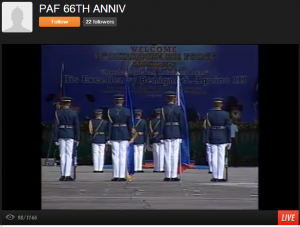 |
Timeline: Kalayaan Sheltered Port project (Updated for May 2014)
Monday , 17, June 2013 External defense Leave a commentNote: This article has been updated on to include information about House Bill 4167
The fishermen and municipal workers and families that live on Pag-asa Island comprise the most isolated civilian community in the Republic of the Philippines. The island, the largest of eight (8) Philippine occupied coral outcroppings in the Municipality of Kalayaan, is approximately 509 kilometers northwest of Puerto Princessa and 828 kilometers southwest of Metro Manila. Once a strictly a military installation, Pag-asa was opened to civilian settlement in 2002.
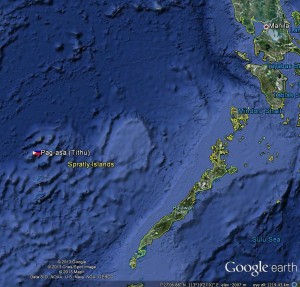 |
Since the creation of the settlement, the Municipal government of Kalayaan has established a range of facilities that provide vital public services that are expected of a functional community. Pag-asa has a power station consisting of a solar panel farm, charging a bank of 48 batteries, as well a conventional fossil-fueled generator to provide for the island’s electrical needs. The island’s reverse osmosis plant converts seawater into potable drinking water that residents collect from the plant. Water for domestic use is piped into individual homes.
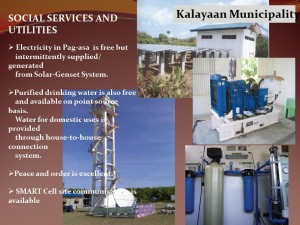 |
Smart Telecommunications established a cell site, connected to its main network via VSAT (Very Small Aperture Terminal), on the island in 2005 making normal GSM-based cellphone communication with the island possible. The first call on the system took place on June 12 at 5:18 PM between the mayor of the municipality at the time and a Smart Telecom executive. The company completed a maintenance visit to the cell site in 2011, thus ensuring continued operation of the facility.
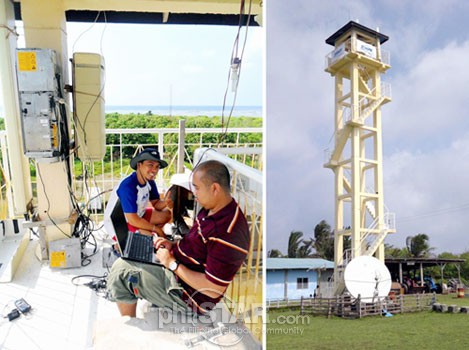 |
In 2012, the municipal government entered into a Memorandum of Agreement with the Department of Education to establish the Pag-asa Elementary School. There are currently 24 children that call Pag-asa, Kalayaan home. Fourteen are from fishing families, while the other 10 are children of municipal workers. Children of the latter go to school in Palawan. As of last year, 8 of the 14 enrolled in the Pag-asa Elementary School. Five were still too young to go to school and were candidates for the next school year. One child was un-enrolled. By mid-school year, the teaching staff at the school had expanded to two teachers. The school started with municipality’s multi-purpose hall which residents converted for its current purpose. Two buildings will be added this year. One funded by the Ayala Foundation is currently under construction. Another is being funded by the Provincial Governor of Palawan.
| First classroom | First graduation |
 |
 |
Continued development of the island and the rest of the municipality hinges on the availability of reliable and regular transportation to the rest of the country, especially the province of Palawan. This would facilitate the transport of goods and materials to the islands, and promote socio-economic activity — whose development has thus far been painfully slow.
Pag-asa Island is one of only two islands in the Spratly Islands with a functional airstrip. The Armed Forces of the Philippines constructed the Pag-asa airfield in the early 70’s and named if after the visionary PAF Commanding General that ordered its construction: Jose Rancudo. To date, however, there are no scheduled commercial flights to the municipal seat of power, save for periodic flights by AFP aircraft (the runway can accommodate the C-130 Hercules cargo planes and host of smaller aircraft). Charter flights have reached the island in the recent past. But with costs of reportedly P100K per charter, this would be too cost-prohibitive for local residents.
The primary means by which settlers travel to and from the closest Philippine landmass — Palawan — is by sea. Up until recently, passage to the island primarily by way of Philippine Navy ships. Civilians would be taken aboard as passengers on navy warships which re-supplied the various garrisons on Philippine-held islands. The Municipality expanded the community’s transportation options by acquiring its own vessel: the 40-meter M/V Queen Seagull.
Ship-to-shore transfers however are difficult because of the absence of port facilities. During the monsoon season, vessels have to drop anchor approximately 5 kilometers to the east to a submerged reef that provides comparatively better shelter than the waters around Pag-asa itself. This deficiency also means that the Bureau of Fisheries and Aquatic Resources (BFAR) and Philippine Coast Guard (PCG) are unable to station patrol craft in the area to enforce environmental protection and similar laws. As had been reported on numerous occasions in the Philippine press, poachers are able to wreck havoc on the coral reefs within sight of Pag-asa authorities who were powerless to take appropriate action. The Philippine Navy is similarly unable to pre-position vessels for sovereignty patrols. The nearest naval station with a functional pier is in Ulungan Bay in Palawan which is over 500 kilometers to the east of the island.
For this reason, the Municipality of Kalayaan proposed the the Kalayaan Sheltered Port project. The Municipal government used the following graphic in one of their presentations to various national government agencies. It shows the location of the proposed port as well as the rehabilitated runway.
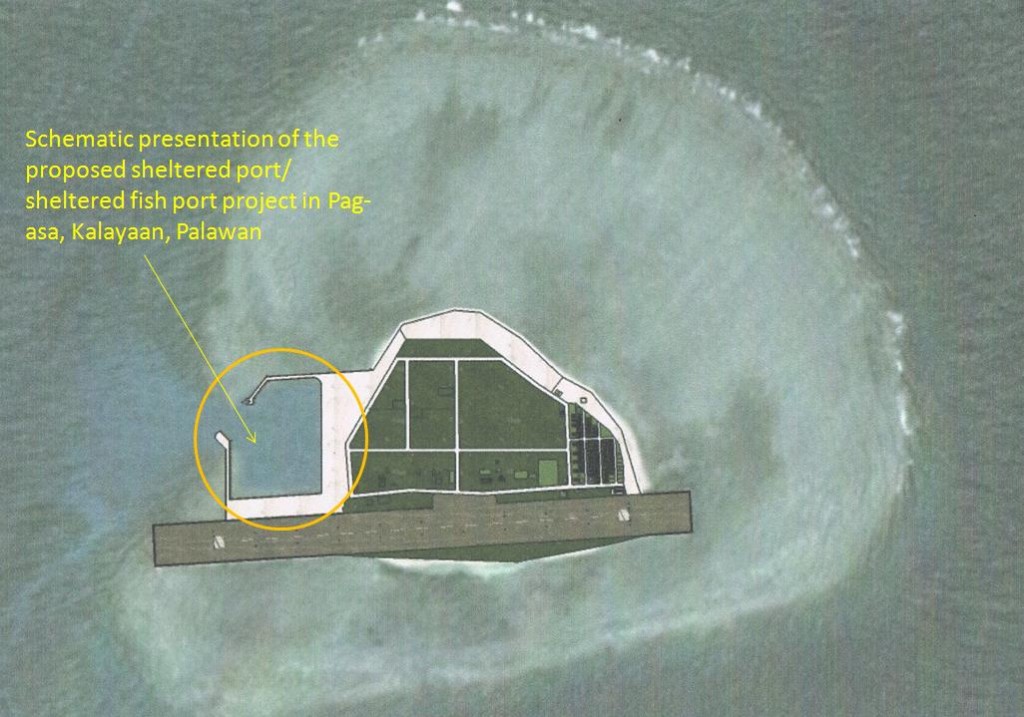 |
The following table chronicles the twists and turns that this project has taken. Efforts to create a port have been initiated in the past. However this article will focus on the most recent project. Updates will be posted as new information becomes available . . . both current and historical.
| Date | Description | Relevant documents | ||
| June 22, 2011 | Upon advice of the Philippine Ports Authority, the Office of the Municipal Mayor brought its appeal for funds to build port facilities on Pag-asa to the Office of the President. The letter suggested tapping into Malampaya proceeds for the project. |  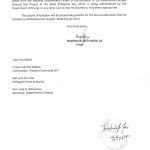 |
||
| July 5, 2011 | Office of the President referred the matter of the port facilities to Secretary of the Department of Agriculture (DA) for appropriate action. Note the inclusion of a patrol craft in the request, which was not mentioned in the initial correspondence in June.The rationale for why the request was routed to the DA instead of the Department of Transportation and Communication (DOTC), which has oversight over the Philippine Ports Authority, is unclear. | 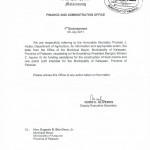 |
||
| July 19, 2011 | Department of Agriculture acknowledged receipt of correspondence from Office of the President and indicates that the matter has been referred to Director of the Bureau of Fisheries and Aquatic Resources (BFAR) | 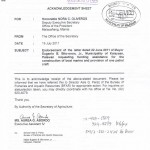 |
||
| August 4, 2011 | Office of the Municipal Mayor sends a letter to the Department of Transportation and Communications appealing for assistance to build port facilities on Pag-asa Island. This line-of-communication is separate from the one that eventually went to the Department of Agriculture. |  |
||
| August 10, 2011 | The BFAR asks the Municipality of Kalayaan to submit a formal project proposal that includes designs and drawings of the proposed port as well as technical specifications for the requested patrol craft. |  |
||
| August 19, 2011 | DOTC informs Kalayaan Municipal government that the Kalayaan Shelter Port has been included in the DOTC infrastructure program for Calendar Year 2012. The letter, however, notes that continued action on the request hinged on Congressional deliberation and availability of funds.The Kalayaan port is included in the National Expenditure Program (NEP) for 2012. See here. An excerpt of the relevant section of the document appears to the right of the aforementioned letter. | 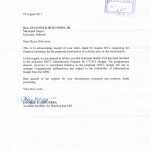 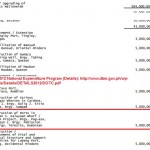 |
||
| December 15, 2011 | Office of the President signs Republic Act 10155, General Appropriations Act of 2012, into law. This budget allocated the sum of P5M to the development of two ports on Palawan, to include the port in Pag-asa, in accordance with the DOTC proposal for the NEP. See page 3 of this Department of Budget and Management (DBM) document. Relevant excerpt appears on the right.As per DBM guidance, funds allocated in this budget are only available until December 31, 2013. See here. | 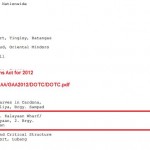 |
||
| February 2, 2012 | Municipal government sends message to BFAR, amending original request to exclude patrol craft and focus instead on port facilities.Photographs and graphic representations of the proposed facilities, as well as a photo what the Vietnamese had done on Pugad Island, were included | 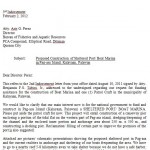  |
||
| March 28, 2012 | Kalayaan Municipal government responds, via email, to an urgent request from the DOTC for information about the scope of work, and specifications of the port.The response mentions a conference between the Philippine Ports Authority and the Flag-Officer-In-Command (FOIC) of the Philippine Navy on March 21, 2012 where both parties agreed to pool their resources to construct the port. Both agencies put forth their respective proposals. The Municipal government expressed preference for the Philippine Navy proposal.The Municipal office, admitting to a lack of expertise, referred the DOTC to the aforementioned agencies for the technical details. | 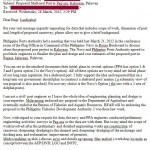 |
||
| March 30, 2012 | DOTC requests that the Kalayaan Municipal government present a thorough feasibility study of the project, that included justification for the project (e.g., technical, social, financial, and economic aspects), as well as details designs of the proposed port.The email indicates that this information is part of budget planning for 2013. However, the Pag-asa port project is not included in the DOTC section of the National Expenditure Program for 2013 (see here). Funds allocated in the 2012 budget, however, remain valid till the end of 2013. |  |
||
| August 30, 2012 | DOTC requested the Municipality of Kalayaan for information about previous studies conducted by the PPA/DA or the AFP about the feasibility of constructing a port. This data will reportedly be use for the drafting of a Term of Reference (TOR) for hiring of consultants for the drafting of a Master Plan for the project. |  |
||
| July 17, 2013 | In response to an update request from the Municipality of Kalayaan, the regional DOTC office relates that an un-named Under Secretary sought information about the purpose of the port — seemingly oblivious to the discussions between the municipality and various national government entities over the past three years |  |
||
| July 17, 2013 | Office of the Municipal Mayor of Kalayaan sent the following exasperated response to the latest information request from the DOTC |   |
||
| December 8, 2013 | Office of the Municipal Mayor of Kalayaan sought the assistance of Congressman Teddy Brawner Baguilat (Lone district of Ifugao), one of the members of a congressional delegation that visited Pag-asa island in 2011, to push for the realization of the port project. | 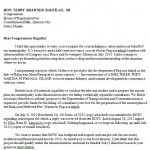 |
||
| March 12, 2014 | Representatives Rufus B. Rodriguez and Maximo B. Rodriguez Jr introduced House Bill 4167, which states the following:”The amount of One Billion Pesos (P1,000,000,000) is hereby appropriated to be exclusively used for the fortification and improvement of current structures present in the Kalayaan Group of Islands. Further, the same amount shall also be used to build new structures in the island like harbors, berthing facilities and other structures necessary to promote tourism in the islands and increase the defensive capabilities of the Philippines to strengthen the Philippines’ claim over it” | 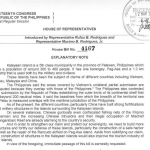  |
||
| May 5, 2014 | As per the House of Representatives legislative database, House Bill 4167 was referred to the Committee on Appropriations |
Other references
RP’s remotest town freed from isolation, Manila Bulletin, June 15, 2005; copy retrieved from Timawa.net June 16, 2013
The promise of Pag-asa, Manila Standard, August 22, 2005; copy retrieved from Timawa.net June 16, 2013
Smart maintains GSM service on Pag-asa Is., Philippine Star, July 30, 2011; retrieved from Timawa.net on June 16, 2013
Chinese fishing fleet closes in on Pag-asa Island, Philippine Daily Inquirer, July 26, 2012; retrieved June 16, 2013
Drydocking the Andradas
Friday , 10, May 2013 Andrada class patrol gunboats, BRP Carlos Albert (PG-375), BRP Jose Andrada (PG-370) Leave a commentThe Philippine Navy recently issued bid invitation notices for the “Drydocking and other related repair” of two of its Andrada class patrol boats:
- BRP Carlos Albert (PG-375): MR-PNBAC-2013-043 for P4,52,782.00
- BRP Jose Andrada (PG-370): MR-PNBAC-2013-042 for P6,751,485.00
Pre-bid conferences for these ships were set on the 3rd and 6th of May respectively. Submission and opening of bid envelopes for both ships were set for the 20th of May.
Prospective bidders were instructed to contact the following PN office:
Office of the PN Bids and Awards Committee Bonifacio Naval Station, Fort Bonifacio, Taguig City Contact person: LT DOMINGO B SUMAYO JR PN Cel Nr: 0917-587-4882 Tel Nr: 889-1301,815-3420 & 843-4416 local 6341 Email Add: pnbac08@yahoo.com
The Andrada class patrol boats are the Philippine Navy’s largest class of patrol boat, numbering twenty-two (22) units, and were built in the early 90s at the Halter Equitable shipyard in New Orleans, Louisana. The class consists of 77-foot and 78-foot versions. The PG-370 and PG-375 are of the 77-foot variety.
Both ships have their respective discussion threads on the Timawa.net forum at the following locations:
PG-370: http://www.timawa.net/forum/index.php?topic=16522.0
PG-375: http://www.timawa.net/forum/index.php?topic=15946.0
Photo of the PG-370 below, c/o Getty Images.
Something I put together for a thread on PinoyExchange
http://pinoyexchange.com/forums/showpost.php?p=32375719&postcount=232
The AFP’s priority is to acquire whatever capabilities it can in the soonest possible time. Given a choice between using imported technology that is available now, or waiting for indigenous solutions to mature . . . naturally they will go with what is already available.
HOWEVER, purchasing items from foreign suppliers does not automatically mean that it is a disadvantage for local industry. The key mitigating factor is in the mode of payment. This is where COUNTERTRADE comes into play. With countertrade, vendors are paid in kind, not money. Government money is used to buy local products which are then used to pay the vendor.
The lead agency for countertrade transactions is the Philippine Investment & Trading Corp. (PITC). Based on PITC statistics, the AFP is the largest user of countertrade transactions. The following modernization items were paid for using countertrade:
-> SIAI-Marchetti S211 trainer jets (Italy): 40% of the amount was paid for with the following items: Crude Coconut Oil, Garments/Fabric, various Copra products, various Porcelain, Black Tiger Prawns, Activated Coco Carbon, various Handicraft
-> Squad Automatic Weapons (Belgium): 85% of the acquisition was paid for with semi-processed rubber
-> Harris communication equipment (USA): 100% paid for with semi-processed rubber products, dessicated coconut, various handicraft
-> 105mm howizter upgrade (France): 100% paid for with copra products, desiccated Coconut, canned Tuna, assorted handicrafts
This is an update of last year’s article on defense spending (see here). The 2013 graph shows a disturbing P26.5M drop that may give the impression that the Philippines was reducing its defense commitments. This, however was there result of a shifting of responsibility for certain funds from the Department of National Defense to other departments.
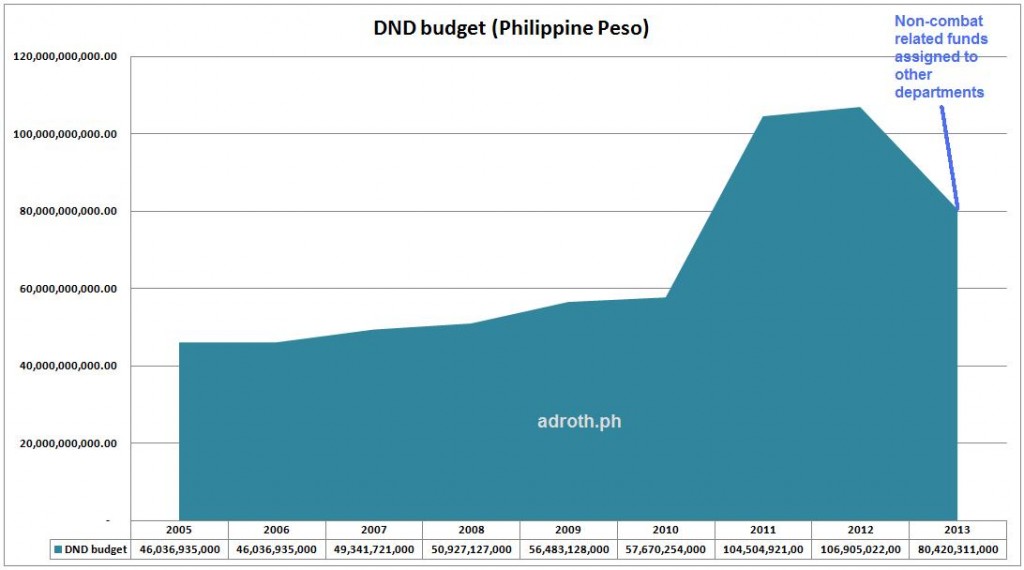 |
A review of service-level budgets actually show a continuation of the upward trend of the past five years.
 |
The allocation for the AFP Modernization fund remains at P5 billion.
Spot the difference between different Golden Eagle versions using the following images taken from the KAI Website. Do the following:
1. Open a tabbed browser (latest versions of Chrome, IE, Firefox fall in this category)
2. Copy the following links to a different tabs:
http://adroth.ph/afpmodern/wp-content/uploads/2012/09/fa50.jpg
http://adroth.ph/afpmodern/wp-content/uploads/2012/09/ta50.jpg
http://adroth.ph/afpmodern/wp-content/uploads/2012/09/t50b.jpg
http://adroth.ph/afpmodern/wp-content/uploads/2012/09/t50.jpg
3. Switch from one tab to the next. Focusing on the three views of the aircraft at the bottom, the ones with dimensions.
Note what changes . . . and what doesn’t.
